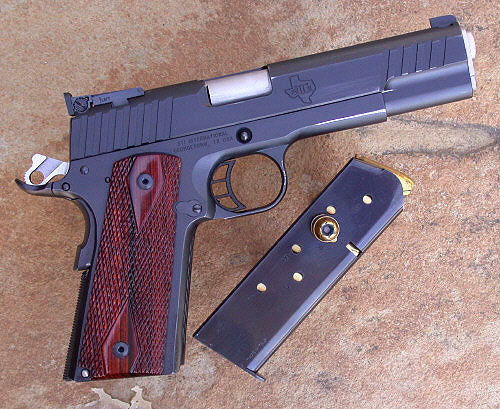
Comparing the STI Trojan and Legacy Pistols
STI is a manufacturer of 1911 pattern pistols based in Georgetown, Texas. Their pistols include both single and double stack guns and they're seen frequently on competition circuits and are sold all over the world.
This article will focus on two of their 45-caliber single stacks. One is their workhorse version called the Trojan while the other is a newer design that they've named the Legacy.
I reckon the Trojan might be called their "entry level" single-stack 1911, but "entry level" is a relative term for STI handguns are not inexpensive and neither is the Trojan. It is just less costly than their other full size 1911-pattern pistols. It is currently offered in both the standard 5" barrel/slide length as well as the 6" long slide version and can be had in 9mm, .38 Super, .40 S&W and .45 ACP. In contrast, the Legacy is offered only in 5" and .45 ACP. It is also more expensive than the Trojan.
This article will take a close look at both guns and I'll offer my own experiences with each.

This STI Trojan .45 ACP is an older gun and has the flat front strap but current guns have the traditional rounded one. I changed out the grip bushings and replaced the factory standard thin stocks with regular thickness 1911 grips. This was simply due to personal preference. In normal trim, the Trojan comes in a "flat blue" finish, but a stainless steel version with the same rear sight as the Legacy is available.
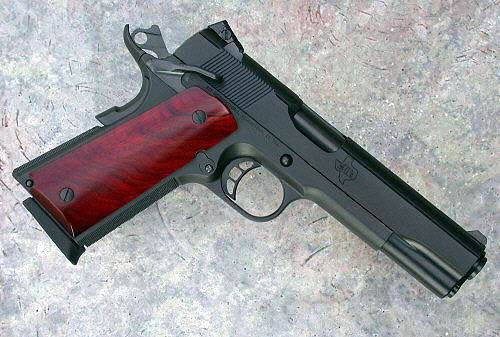
The Legacy comes with smooth Cocobola grips of normal thickness and the ACT 8-shot magazine. The finish is described by STI as PVD, ion bond and is reported to be very resistant to both wear and corrosion. The Legacy's adjustable rear sight differs from the Trojan's Bomar-like adjustable rear and is more compact. It has a serrated ramp front sight while the Trojan offers a post.
Both guns come with FLGR's as well as fitted match grade barrels and bushings. On each, the barrel's OD is slightly wider at the muzzle to insure a tight lock up for better mechanical accuracy. The Trojan has a single-side extended thumb safety while the Legacy comes standard with ambidextrous.
For the most part, the guns appear fairly similar. Are they? Let's take a close up and personal look at these pistols and start off with their specs.
Specifications for the STI Trojan and Legacy:
|
Specifications: |
Trojan |
Legacy |
|
Weight |
36 oz |
38 oz |
|
Grips |
Rosewood, thin panels |
Cocobola |
|
Frame |
Cast |
Forged |
|
Slide |
Bar-stock (4140) |
Bar-stock (4140) |
|
Front Grip Strap |
STIppled |
30 LPI checkering |
|
Slide Serrations |
Front & Rear |
Rear only |
|
Slide Top |
Flat |
Flat w/serrations |
|
Triggers |
STI Lightweight long |
STI Lightweight long* |
|
Safeties |
Grip & single-side |
Grip & ambidextrous |
|
Internal FP Safety |
No |
No |
|
FLGR |
Yes |
Yes |
|
Match Bbl & Bushing |
Yes***** |
Yes***** |
|
Beveled Mag Well |
Yes |
No |
|
Adj. Rear Sight |
Yes** |
Yes |
|
Front Sight |
Plain Post (0.110") |
Serrated Ramp (0.120") |
|
Undercut Trigger Guard |
Yes |
No |
|
LOA |
8.5" |
8.5" |
|
Mainspring Housing |
Checkered Plastic |
Checkered Steel*** |
|
Grip Safety |
STI beavertail |
STI beavertail |
|
Internal Safeties/Locks |
No |
No |
|
Hammer**** |
STI Commander |
STI Commander |
|
Recoil Spring |
16-lb |
16-lb |
|
Mainspring |
15-lb |
15-lb |
|
Ejector |
Long |
Long |
|
Extractor |
Internal |
Internal |
|
Magazine Release |
Plain |
Dimpled |
|
Finish |
Flat Blue |
PVD Ion Bond |
*On my Trojan, the trigger is coated with a polymer. On the Legacy, it is not. (STI has incorporated some changes in their Trojan line since I purchased mine. These will be discussed later.)
**On the blue Trojan, the Bomar-type adjustable rear sight is used. On the stainless Trojan and Legacy, STI uses their T.A.S. (Tactical Adjustable Sight). It resembles the Novak and is more compact than the Bomar style.
***The bottom of this checkered mainspring housing is drilled and tapped for use with a magazine well if desired.
****STI hammers and sears are of S-7 tool steel and wire-cut with computer assisted machining.
*****STI match barrels are made of stainless steel.
(FWIW, the front sight dovetail dimensions are .300" X .060" X 60 degrees.)
The Legacy has the usual "dished out" scallop at the rear of the lowered ejection port. While the Trojan also has a lowered port, the "dished out" area is more of a bevel. In either event, both pistols eject cleanly and neither dents cases, be they from standard pressure to warmer loads, both factory and handloaded.
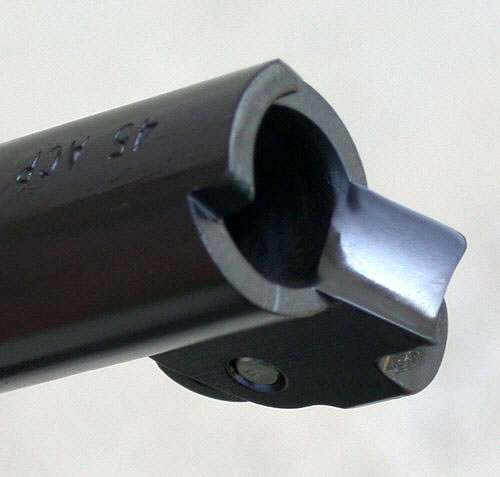
The Legacy barrel uses a one-piece feed ramp. My older Trojan uses the standard two-piece arrangement and has been utterly reliable. I had concerns over this change, but it seems to work fine with several different JHP rounds as well as handloaded cast SWC's.
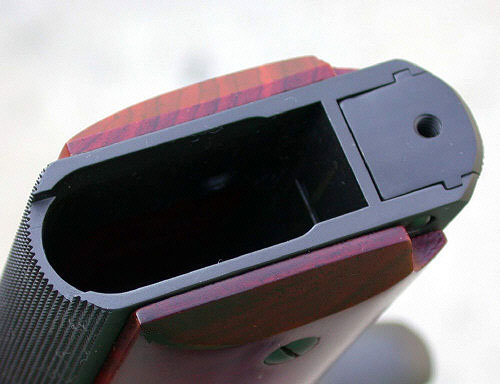
Here is the Legacy's magazine well. It is not beveled in the traditional sense as is the Trojan's, but it is wider. I'm not the fastest to be sure, but rapid magazine changes have not been a problem with this gun. Also visible is the drilled and tapped hole should one want to add one of the beveled magazine wells favored by more than a few 1911 shooters. The nicely done front strap checkering is also visible.
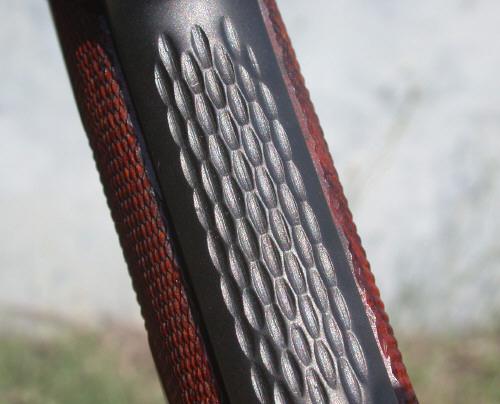
Here is a front view of the "scalloped" front strap on the Trojan. STI refers to this treatment as "STIppling."
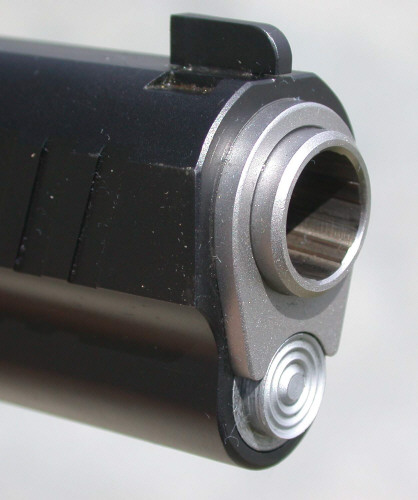
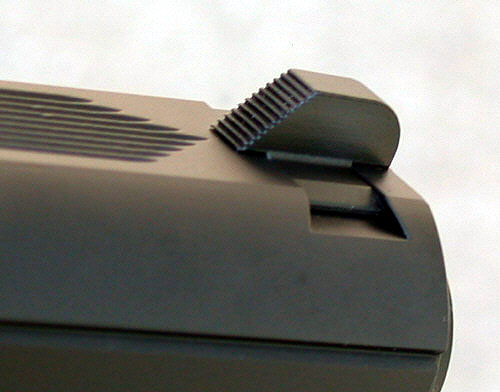
On the left is the muzzle of the STI Trojan showing the stainless bushing (and spring cap I added when going to the GI-type spring guide.) Its post sight is evident, as is the flat atop the slide. On the right is the Legacy's serrated ramp with the "diamond" cut lengthwise serrations atop its slide.
Personal Changes Made to Both Pistols: Both of these pistols will probably be satisfactory as they come for the vast majority of shooters. I have but one Legacy and three Trojans for comparison, but all came with very, very nice trigger pulls that break cleanly and with very little over travel. The screws limiting this have not moved at all. I did very little to either of these pistols and what I did might be exactly what others would avoid doing or see as senseless. Still, I see it as my money, my pistols, and my preferences. First, I replaced the FLGR's in both guns with the traditional GI recoil spring guide and cap. The reason is that I simply prefer them. As was mentioned previously, I replaced the short grip screw bushings on the Trojan with standards and stuck on a pair of regular thickness checkered grips. I also replaced the flat checkered plastic mainspring housing with a steel one. On the Legacy, I replaced the very nice smooth grips with a pair of checkered ones.
As expected, none of these minor changes affected accuracy, function, or smoothness of operation one wit.
Shooting: Neither of these pistols has been shot extensively. Since I've owned the Trojan longer, I've had the opportunity to crank off more rounds with it. I'd estimate that it has fired a bit over 2500 shots. The Legacy, as this is written, has fired approximately 500 rounds.
All but a couple of dozen shots have been with loads at least in the 200-gr. @ 870 ft/sec range, with most being full power or warmer with 230-gr. bullets. Both pistols have never experienced poor or erratic extraction/ejection and neither pistol dents fired cases upon ejection. Neither has suffered hammer drop despite their very nice trigger pulls, which I estimate at about 4 1/4 to 4 1/2 pounds. Both have remained constant as well.
Other than with one too-light target load for the Trojan's recoil spring, it has had zero malfunctions. The slide has never failed to lock back on the last shot, regardless of magazine brand and with standard power ammunition, it has never failed to feed, extract/eject or malfunction in any manner. This one feeds all JHP ammunition smoothly that I've tried. Commercial ammunition includes Federal 185-gr. JHP, Federal 230-gr. JHP, Federal 230-gr. HydraShok as well as Speer 230-gr. Gold Dots and Remington's Golden Saber. Handloaded rounds have included cast 200-gr. SWC's, 230-gr. FMJFP and ball, 230-gr. Golden Sabers, 200 and 230-gr. Hornady XTP's, Corbon 185-gr. DPX +P, as well as Winchester Ranger 230-gr. JHP's.
When being shot the first time, the Legacy balked on a full 8-round magazine when chambering a Speer 230-gr. Gold Dot by hand. It never burped during firing and has not balked on this cartridge since. With all other JHP's, ball, and SWC's, it has worked flawlessly.
I note no difference in felt recoil between these pistols. The slightly relieved area under the trigger guard on the Trojan seems to make no difference for me. Some may note that the Trojan's listed weight is 2 ounces less than the Legacy. I weighed a flat steel mainspring housing and it registered 2 ounces. Since I have steel mainspring housings in both guns, there is no significant weight difference.
The well-fit grip safeties on both pistols eliminate any chance of hammer bite and I find them good looking as well.
Each pistol's plunger tube was closely checked. Neither was loose when I bought the pistols and both have remained the same way. On both, their respective thumb safeties are easy enough to engage/disengage and are positive in either the "on" or "off" positions. There is no mushiness. I find STI's thumb safeties to lend themselves nicely to shooting "high thumb", but shooting "low thumb" has not induced any inadvertent safety engagements. Wearing either in a close to the body concealment holster (OWB) has not resulted in any wiping off of the thumb safety with the Legacy. The same has been true when wearing the Trojan in an IWB holster.
As seems to be the case with many 1911 pattern pistols today, I do find it necessary to retract the plunger with a knife blade when reinserting the slide stop during reassembly with my Trojans and Legacy.
Never having been one for lighter-than-normal springs, I initially was concerned when I learned of the relatively light-powered 15-lb mainspring used in the Trojan and Legacy. It appears that my fears have been unjustified. I have never suffered a single failure to detonate any primer that's been in a chambered cartridge. This includes Winchester, Remington, Federal, CCI Speer, as well as the often-hard primered Sellier & Bellot .45 ammunition.
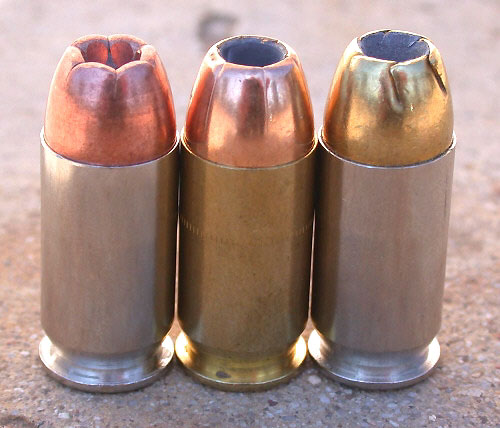
Both the STI Trojan and Legacy fed these 230-gr. JHP's without hesitation. From left to right they are Winchester Ranger JHP, Federal Classic 230-gr., and Remington Golden Saber.
For those interested, I have found that neither the Trojan nor the Legacy suffers reliability problems if using a shock buffer. Each runs just fine with or without one.
Accuracy: I found both pistols capable of more mechanical accuracy than I can wring out of either. From a rest, I can get groups in the neighborhood of 2" and sometimes less at 25 yards, but I have little doubt that more accomplished shooters could pare group sizes more and more consistently. The farthest I shot both pistols has been about 65 yards and hitting bowling pins is no problem with either. In short, I'm saying that these 1911-pattern pistols are capable of greater accuracy than most of us can see, particularly under field conditions…and I see that as a good thing.
I have also fired several five-shot groups loading each pistol with but one round, firing it and repeating the process to see if the STI Trojan or Legacy suffers from "First Round Flyer Syndrome." I am very happy to say that they do not.
FWIW, on neither pistol did I have to move the rear sight elevation or windage-wise more than a click or two and both adjustable rear sights have held true.
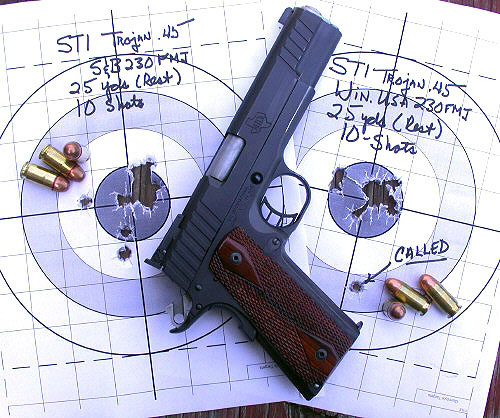
These two targets were fired from a seated position with my wrists braced and are about normal for me with the Trojan…called flyers and all!
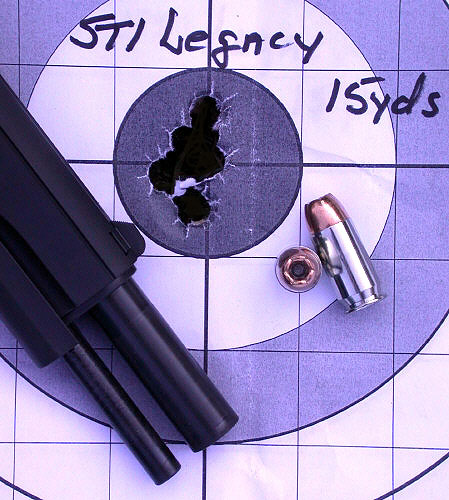
This 15-yard group was also fired from a rested position with wrists braced using the STI Legacy. (I'd have used a 25-yard target, but apparently don't have a picture of one that I can find!) The ammunition used in this instance is Winchester 230-gr. Ranger. In my hands, both pistols perform equivalently and I'm more than happy with the mechanical accuracy shown by either. Obviously this photo was taken before I removed the Legacy's FLGR.
I have not yet had the opportunity to chronograph ammunition from the Legacy to compare to the Trojan. With the latter, most factory loads group quite well and the quality of the STI barrel no doubt contributes to the normally small extreme spreads and standard deviations that I've come to expect with this pistol. I expect no negative surprises with the Legacy.
The bores on both the Trojan and Legacy barrels are smooth. I've noticed them to be easier to clean than some of my other .45 1911 barrels.
I am convinced that with either the Trojan or the Legacy if I get a miss, it is because I missed.
Observations: Both pistols shoot very well and both appear reliable in the extreme. I have not yet had the time required to see how durable the Legacy's ion bon black finish is, but it appears not to show any holster wear after perhaps 300 presentations. It does show some wear in places where parts finished with it can rub each other. For example, bare metal is exposed beneath where the slide stop lever moves and touches the frame. STI's Chris Schirmer advises that the finish is both durable and highly resistant to corrosion. I suspect that it will serve me well and I find it quite an attractive finish.
The Trojan's magazine release holds the magazine approximately 0.02" higher than other "standard" magazine releases. Such is also the case with my 9mm and .38 Super Trojans. The Legacy's magazine release does not appear to do so. Perhaps it is not deemed necessary for utter reliability with the straight one-piece feed ramp. In any event, my Legacy runs just fine. I do find that the little dimple on the Legacy's magazine release "grabs" the thumb more than might be expected, but fully admit that the smooth button on the Trojan has never caused me any problems.
Both pistols have been fired with Colt, Wilson, McCormick, ACT, Mec-Gar, and old Randall magazines. All dropped free of the guns when released and reliability was not affected. The Trojan and the Legacy always locked the slide back after the last shot…and not before.
I asked Mr. Schirmer if STI envisioned the Legacy more as a range or carry gun. He replied, "Both." He went on to add that the smaller T.A.S. rear sight on the Legacy lends itself more to carry than the Bomar-type adjustable rear sight on the blued Trojan. Because the stainless Trojan might be considered for carry due to its stainless construction, the T. A. S. sight is standard on it rather than the one on the blued gun. The Legacy has a rust-resistant finish that is dark, something preferred by a good number of folks who routinely carry for serious purposes.
Both guns use the same STI internal parts according to Mr. Schirmer, the only obvious difference being the ambidextrous safety on the Legacy.
Earlier I mentioned that both guns' barrels have a larger OD at the muzzle than farther back. The Trojan exhibits this trait for a fraction of an inch while the Legacy's extends rearward considerably farther. I note no difference in accuracy.
A feature that I particularly like about the STI Trojan and Legacy is the way that the guns are fit. I have no really good way to measure it, but lateral play in either pistol's slide-to-frame is nearly nonexistent. Neither exhibits any felt vertical play. Neither gun's barrel moves an iota with the slide forward. Both guns group very well, but no extra effort is required during the last bit of locking up to achieve it. The slides just "glide" into place, seemingly w/o effort, but are tight as that proverbial hatband when in battery. Both guns' barrel hoods are evenly marked where they contact the breech face, not just on one side or the other.
The Legacy's checkered front grip strap offers a more secure grip for me than does the STIppling on the Trojan. Though I personally prefer 20 LPI checkering, the finer checkering on the Legacy is quite satisfactory.
To me, the Legacy is a distinctly handsome pistol, but this is purely subjective. I have a distinct dislike for forward slide serrations, particularly wide ones…as are on all three of my STI Trojans. That said, this cosmetic "defect" did not keep me from buying two more once I'd tried one!
The Trojan's cast frame bothers me not at all. I've been shooting a Caspian/Colt build using Caspian's cast frame since the mid-80's for untold thousands of rounds and it's still going strong. Likewise, in more recent years, I have no idea how many thousands of full power and +P 9mm rounds I've sent downrange with the cast frame FN/Browning Mk III Hi Powers. Again, no frame failures have been experienced. Somewhere out there I'm sure a quality cast frame has cracked or failed…just like the forged ones I've seen. Whether forged or quality cast, it strikes me that frame failure and when it occurs is more of an individual frame thing than something that can be predicted in general for the respective process. I have no doubts that my Legacy's forged frame will hold up to thousands upon thousands of rounds. What I'm saying is that for me, the cast vs. forged frame is not an issue with me when from a quality manufacturer like STI.
Both guns are free of all but the tiniest machining marks inside and normal wear marks are evenly distributed on both sides of the respective pistols.
Were I going to buy a gun for the range, the field, or even carry and could clean the pistol shortly after each outing, I think that the Trojan would be difficult to beat. If I wanted more corrosion resistance, I could have an aftermarket finish applied or simply buy the stainless Trojan. If I wanted more compact adjustable sights than come on the blued Trojan and didn't want to come up with the extra bucks for the Legacy, I'd go with the stainless Trojan since it uses the T.A.S rear sight. If I wanted a dark, corrosion-resistant pistol for the field, defensive or duty carry, and was not wed to fixed sights, I'd go with the Legacy if at all possible. (It is my understanding that STI can install fixed sights that fit either the Novak or Bomar cuts.)
Both guns have flat tops, a feature I sort of like on the 1911-pattern pistol. I prefer the serrated top on the Legacy to the Trojan's plain one, but like the "master line" that runs atop and lengthwise the slide flats, I see these as cosmetic refinements. I rather like them but am not convinced that they make the Legacy a "better" pistol in practical terms.
My .45 Trojan has proven itself to me and I'd not be afraid to use it for serious purposes. Were I going to regularly carry it concealed, I'd round the edges of the rear sight. For carry, I do believe that the compact T.A.S. is better. Both present very fine sight pictures for me. I've not fired the Legacy enough to wholeheartedly carry it for self-protection, but I think that it will prove itself with more shots; in fact I have little doubt of it.
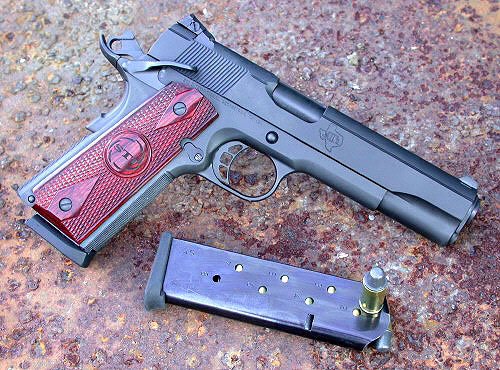
Here is my Legacy after roughly 500 total rounds fired. Note that the barrel is not marked from slide movement. Some wear is visible where the right-side thumb safety lever contacts the slide. I am extremely fond of this pistol and think that it's in its final configuration for me. A friend purchased a Legacy at the same time I bought this one and he is pleased with his pistol as well.
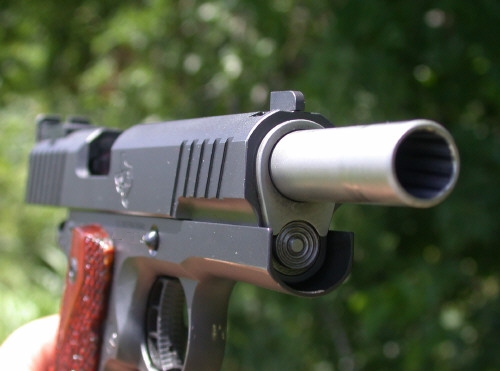
My STI Trojan .45 has proven itself to me. I would trust this pistol in self-defense situations without question.
Between the two, my favorite would have to be the Legacy. That said, my Trojans are going nowhere soon unless it's to the range.
For information on pricing, features, or other questions, drop by
www.stiguns.comIf you want a 1911-pattern pistol that is well fitted, accurate, and reliable, and bereft of internal firing pin safeties, I strongly suspect that there's an STI pistol for you. They are not inexpensive but I do not suffer the least bit from "buyer's remorse" on any that I've purchased.
The STI staff has been very helpful and eager to help with questions I've asked about their guns and they seem a great group of guys and ladies. I'm told that their customer service, if needed, is outstanding.
Best.